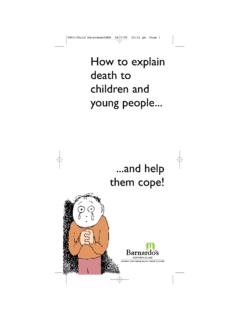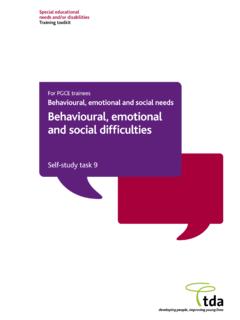Transcription of We can work it out. What works in education pupils …
1 Abc 1 We can work it out. What works in education pupils with social , emotional and behavioural difficulties outside mainstream classrooms? Summary Author: Paul Cooper Date published: 2001 The What works ? Series Every child has the right to expect that professionals intervening in their lives will do so on the basis of the best available knowledge. Some ways of dealing with problems work better than others, but the majority of interventions in social care are not evaluated before they are introduced. In that sense much of the work done with children is an uncontrolled experiment. Barnardo's has a special interest in evidence-based practice - that is, finding out what works and ensuring that the interventions we and others make in children's lives are as good as they can possibly be. The series of "What works ?" reports draws on a range of research designs and evaluations which suggest that particular approaches are worthwhile.
2 This report in brief We can work it out reviews what works in educating pupils with social , emotional and behavioural difficulties (SEBD) in non- mainstream settings. It assumes that for the time being, non- mainstream settings will continue to have a role for a small group of children whose challenging and disturbing behaviour means that they are difficult to educate in mainstream schools. Although some children may find their educational needs best met in non- mainstream settings for considerable periods of time, it is nevertheless important that non- mainstream provision is systematically integrated within the education system as a whole. Answering the question 'what works ?' in relation to SEBD is not easy. The review draws on a number of studies to assess the effectiveness of different approaches. In highlighting examples of successful work in this difficult area, the report draws on the evidence from past and current experience, and shows continuities in theory and practice across time and educational settings.
3 Four main questions are addressed in this report: abc 2 What do we mean by social , emotional and behavioural difficulties ? In the past, what has been the contribution of non- mainstream educational provision to the educational, social and emotional development of students with SEBD? In the current era (the present and recent past), how has non- mainstream educational provision for students with SEBD developed, and what are the circumstances associated with its effectiveness? What future developments in provision for students with SEBD are likely to enhance its effectiveness, and what circumstances ( in relation to policy, educational theory and professional practice might facilitate such positive developments? What do we mean by social , emotional and behavioural difficulties ? SEBD are very common and increasing.)
4 It is estimated that in England and Wales between 10% and 20% of school age children experience SEBD to a degree that significantly impairs their social and educational development. SEBD take different forms, such as acting out, phobic and withdrawn behaviour. They include crime, substance abuse, depression, suicide and self-harm. Children and young people with SEBD frequently disrupt classrooms and playgrounds. They are at particular risk of being excluded. Attitudes to them are often very negative. There are many causes of SEBD, but social factors almost always play a crucial role in their development. The prevalence of problems reaches its peak in the adolescent years. It is difficult to make international comparisons but the situation in the USA appears to be similar. abc 3 Lessons from history Understanding how theory and intervention have developed in the study of SEBD can help us make sense of current policy and practice and help us plan for the future.
5 It can also help us to avoid re-inventing the wheel. In the early nineteenth century, approaches to SEBD tended to locate the source of difficulties in the individual and tried to retrain the individual following the dictum of 'spare the rod and spoil the child' although there were some pioneers who established less harsh methods. In the twentieth century, there was an increased use of therapeutic as opposed to punitive approaches to dealing with SEBD. The early influence of psychodynamic approaches gave way to environmental approaches. Some residential schools have been very effective in meeting the needs of students with SEBD. They have provided structured programmes involving student self-government and therapeutic relationships, educational and residential experiences in a 24-hour curriculum. The best day provision, in the form of schools and units, have clear goals and entry criteria, a structured therapeutic and sometimes behavioural programme, high quality social relationships between staff and students, and positive social outcomes.
6 The advent of behavioural and cognitive- behavioural approaches in psychology coincided with a shift in emphasis from a therapeutic psychology to educational psychology, as shown in the recommendations of the Warnock report. Major developments in education policy since 1980 have affected approaches to SEBD. In particular there is a new emphasis on considering 'what works ' in alternative provision for students with SEBD within the context of educational policy as a whole. There is also growing awareness that teachers are asked to help students engage with an educational system and culture that sometimes seems indifferent or hostile to their needs. abc 4 Special schools, pupil referral units (PRUs) and Learning support units (LSUs) There is some evidence of promising and good practice in special schools and units. Such provision can be effective in promoting the positive social , emotional and academic progress of students where: there are clear entry and exit criteria there are supportive relationships between staff and students, and efforts are made to forge co-operative relationships with families and outside agencies explicit attention is given to the formal curriculum.
7 The arrival of the National Curriculum in England and Wales seems to have created difficulties for works in the small scale, non- mainstream provision. It had also, however, been seen as a positive challenge since it gives a framework for extending the scope of the work. This, and OFSTED's greater influence on PRUs, has been useful in encouraging more attention to the formal curriculum. OFSTED has also helped workers to reintegrate students, where possible, into mainstream education or refer them on to an appropriate alternative or post-school form of provision. Combining educational and therapeutic approaches A number of current approaches use educational and what have been termed 'therapeutic' approaches to SEBD. Current theories highlight the idea that the social environment and the emotional climate of the educational setting have an enormous influence on learning processes.
8 Students learn better when they feel safe and secure and the risk of failure is not experienced as a threat. Some specific approaches are discussed, such as: Peer support practices - where students are trained to offer support to young people in the same school. Circle time. This aims to build students' self esteem by giving them time to speak about their feelings and concerns, providing an open forum for discussion, providing the setting in which success is celebrated and rewarded. This model is now widely used in special and mainstream schools across the UK. Adult mentoring schemes - where an older person is involved in giving advice and guidance to the young person. Important features of the most successful approaches are: abc 5 emotional competence Communication skills Mobilising student support Recognising the importance of attachment in the early years The need for responsibility and self-directedness in adolescence The power of the caring institution.
9 Multidisciplinary and systematic approaches In recent years there has been more interest in contextual factors that go beyond the individual, the classroom and the school. The ecosystemic approach emphasises the relation between the individual and the wider social system, including the family and school and lends itself naturally to multiprofessional and multidisciplinary working practices. Conclusions Although there are gaps in what we know some clear messages emerge: Children and young people with SEBD deserve careful educational input, designed to promote their positive adjustment and development. There are no quick fixes or single answer solutions to SEBD. There is, however, much knowledge available and many interventions to choose from. The most promising interventions acknowledge that SEBD are often best seen as signs of unmet need.
10 One of the biggest risks for children with SEBD and their families is that they can become isolated. Schools, units and other services which work with such children and young people can also find themselves isolated. Effective interventions are those that combat isolation and promote interpersonal relationships. Through positive contact with others the child, crucially, begins to learn to trust, and to engage confidently with the outside world. Non- mainstream forms of provision have a major role to play in addressing the needs of pupils and students with SEBD. There is a wealth of expertise and experience in these settings that abc 6 will not only benefit the pupils and students they serve but, where services are effectively co-ordinated, will also promote social and educational inclusion for individuals with SEBD.


















